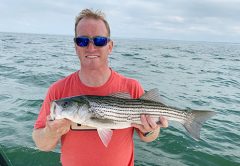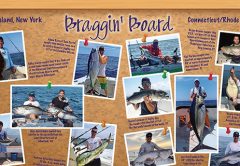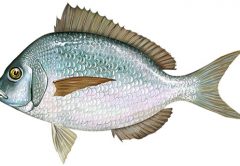W e may be nearing the end of our Long Island wild scallop season, so be sure to take advantage now before the weather gets too warm! North Atlantic sea scallops can be fished commercially by trawling or dredging year-round, but the gold standard on many menus these days are “diver scallops”–hand picked by deep divers or harvested by scallop fishermen near sea grass in the shallower waters of bays and estuaries. Also called bay scallops, these scallops are smaller and generally sweeter than the meatier sea scallop, but then again, the larger sea scallops make great entrees, especially seared and quickly caramelized like a steak.
Luckily, scallops are plentiful, sustainable and no longer on the NOAA endangered list, so eat with them with gusto! In the 1980s and ‘90s, scallops were in decline so new management and rebuilding measures were put into place by the Mid-Atlantic and New England Fishery Management Councils. Clearly, the program worked–including limiting times when scallops are harvested, prohibiting areas where fin fish can be caught up in the scallop fishery methods, and using special equipment on scallop dredges that increase efficiency in catching larger scallops while allowing smaller marine life to return to the sea. Scallop fishermen continue to collaborate with NOAA to design new scallop dredges to reduce by-catch and minimize injuries and capture of sea turtles. Today the Atlantic Sea Scallop Fisheries Management Plan has resulted in scallops reaching twice their long-term average in 1979!
Local, fresh scallops are a delicacy that demands a fairly high market price because of the hand labor involved. Given that the edible part of the scallop is the abductor muscle that holds the two shells together, scallops are shucked by hand at sea and the shells are thrown back into the waters to help keep the aqua-system in balance. The shucked scallops are then immediately iced to keep cold and fresh until sold, so be sure the scallops you are buying from your fish market are local, not imported from China or Mexico!
Cooked scallops should be tender and sweet, so buy them fresh, cold and dry if cooking them yourself. Charlie Manwaring, owner of Southold Fish Market explains that “natural” scallops are sold “dry,” without the additive of tripolyphosphate, a chemical preservative that also helps the scallop “swell.” But do you really want to be eating chemicals for dinner? If not, buy natural or “dry” scallops from independent fish shops that guarantee a local catch. “We sell and serve only dry scallops in our shop,” Charlie says.
The Southold Fish Market is also a great place to eat. Located on the bay at the Port of Egypt marina, it has a great view as well as great food! “Chef” Charlie has been cooking up his grandparents’ recipes since 2000, when he took over the shop. One of his bestselling dishes is grilled Shinnecock Sea Scallops, which he serves as an entree or in a wrap–rolled in a flour tortilla with bacon, lettuce and tomato and their “secret” tartar sauce–as their Scallop BLT. When asked for the special sauce recipe, Charlie says, “I can’t…I promised I wouldn’t ever tell!” The only thing he was willing to give us was that it was onion-based–yum!
Chef Charlie was, however, willing to tell us his favorite way to cook (and eat!) scallops…medium-rare with only a little garlic and butter. “The scallop continues to cook so it should still be a little raw in the middle when you take it off the heat,” he says. Scallops can be served with or without a sauce, Charlie says, “But we like bringing seafood back to the way it was meant to taste…like the sea, not the sauce.”
Some folks say scallops are like tofu–that they taste only like the sauce they are served with–so we challenge Charlie just for fun. He definitely disagrees. “Look, if you want a little different taste, saute the scallops with bacon or roll them in sesame seeds before searing. But every scallop has a different flavor of its own,” he says, “bay scallops are different from sea scallops, scallops from northern waters are different from scallops found in southern waters. But no matter bay or sea scallop,” Charlie continues, “always get them from cold water if possible.”
“The colder the water, the sweeter the scallop,” says Charlie.
[colored_box color=”blue”]
Sauteed Scallops
Ingredients:
(Serves 4)
• 4 scallops minimum per person–5 or 6 if feeling generous (this should be about 1 to 1 1/4 pounds or about 16 to 20 sea scallops, sold “dry”)
• 2 cloves garlic, chopped (or more to taste)
• 3 Tablespoons unsalted butter
• 1 Tablespoon plus 1 teaspoon olive oil
• Kosher salt
• Freshly ground black pepper
• Splash white wine or balsamic vinegar (optional)
Instructions:
1. Rinse scallops with cold water, place on paper towels and thoroughly pat dry. Season scallops with salt and pepper to taste.
2. Add 1 tablespoon butter and oil, each, to a 12 to 14-inch saute pan, preferrably stainless steel or cast iron, on high heat. When the butter is melted and the pan is hot, but before it begins to smoke, add a few drops of water–if the drops sizzle, the pan is ready. Immediately place scallops in the pan, leaving room between each–don’t crowd the pan or the scallops will steam, not sear.
3. To prevent cooked scallops from getting tough, sear them quickly–don’t fiddle with them! Don’t flip them, poke them, or even shake them until you see the bottom edge of the scallop turn that dark caramel color that provides the scallop with it’s delicious browned and crunchy crust, about 1 and one-half to 2 minutes tops.
4. Then flip each scallop once–only once and cook for another minute–again, only one.
5. Remove scallops to a plate to rest. Immediately melt 1 tablespoon of the remaining butter in the pan, the remaining teaspoon of oil and the chopped garlic. Saute until garlic releases fragrance–it should be golden but not brown or it will taste burnt. Add a bit of white wine or balsamic vinegar to deglaze the pan if you like and the remaining butter. Top the scallops with the garlic butter or serve it on the side and that’s it. Seriously, three minutes total is about all it takes to cook a scallop properly–and by that, we mean rare to medium-rare!
[/colored_box]










